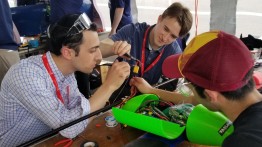Engineering Students Competed in the 4th Annual VFS Design-Build-Vertical Flight Competition
POSTED ON: May 17, 2024

Left to right: Benjamin Meiner, Calder Leppitsch, and Levi Sheridan working on their VFS design.
Mechanical engineering seniors Benjamin Meiner, Ariel Tamayev, Calder Leppitsch, and Levi Sheridan from The Cooper Union participated in the Vertical Flight Society’s (VFS) 4th Annual Design-Build-Vertical Flight (DBVF) Competition held in Churchville, Maryland.
The Vertical Flight Society is the world's oldest and largest technical society dedicated to advancing vertical flight technology. This year's DBVF competition featured nine teams from an original pool of sixteen that entered in October. These teams showcased a diverse array of innovative aircraft designs during the event.
The DBVF competition tasked university teams with several deliverables throughout the year, including a comprehensive technical report, an on-site team presentation, a manually piloted flight performance course, and a fully autonomous flight course. The initial sixteen teams hailed from universities across the United States, as well as from Malaysia, India, and Canada. The primary objective was to design a vertical takeoff and landing aircraft that could operate both manually and autonomously, with a maximum weight of 20 pounds and fitting within a 10-foot sphere. During the competition, teams aimed to complete the most laps around the course while carrying as much payload as possible.
“I really enjoyed seeing a culmination of a year of our hard work during the competition and I am looking forward to seeing how future Cooper students tackle this problem and build on the work we have done" said Benjamin Meiner ME’24.
While The Cooper Union team encountered several challenges during the competition, they demonstrated resilience and teamwork. The day before the competition, a test flight mishap occurred when the motors were accidentally switched, causing the aircraft to flip and sustain damage. The team promptly repaired the aircraft using epoxy. Further issues arose during the competition checks, where the aircraft was found to be overweight, necessitating the removal of non-essential components. During the first hover test, the plane exhibited initial stability but then experienced motor cut-outs, leading to a crash. Upon inspection, the team discovered hot wires, indicating a short circuit or poor wiring. After troubleshooting and resoldering connections, the plane was prepared for another hover test. Unfortunately, the final hover test ended with the aircraft crashing due to uncontrollable oscillations.
"The challenges we faced helped us grow both as individuals and as a team. Each member brought their unique skills and perspectives, and it was inspiring to see how we could combine our strengths to overcome these obstacles," Meiner added.
Despite not completing the course, the Cooper team gained invaluable experience and insights from participating in the DBVF competition.




